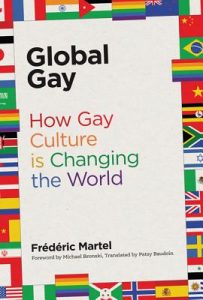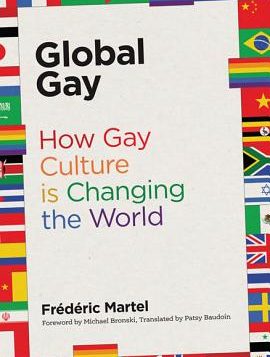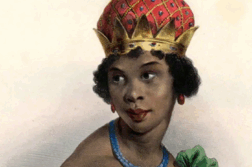 Global Gay: How Gay Culture Is Changing the World
Global Gay: How Gay Culture Is Changing the World
by Frédéric Martel
Translated by Patsy Baudoin
MIT Press. 262 pages, $27.95
“IN IRAN, there are no homosexuals,” Mahmoud Ahmadinejad, the president of Iran, famously said during a lecture at Columbia University when he was in New York to address the United Nations in 2007. Widely mocked for the remark—and rumored, in Iran at least, to be gay—Ahmadinejad is off the world stage at the moment. But the situation in Iran is far more complex than that, we learn in French journalist Frédéric Martel’s engaging book about gay life around the world.
Indeed, the section on Iran, the longest on a single place, portrays the basic contradiction of the entire Muslim world (though Iran is ethnically Persian, not Arabic). There are, in fact, lots of homosexuals in Iran, not to mention bisexuals, and straight men who will have sex with other men because of the strict separation of the sexes before marriage in Muslim cultures. Teheran, Martel learns during a drive around the city looking for a party with a gay fashionista and his friends, is divided into north and south. In North Teheran, the wealthy part, you can go to sophisticated parties at which you may be out; in South Teheran, you cruise the public parks. It’s as if the wealthy can be gay, while the poor are confined to homosexual acts. Even the drugs people take differ: speed and cocaine in North Teheran, crack and heroin in South Teheran.
Martel’s survey of gay life worldwide opens, however, with the June 2016 massacre at Pulse, the nightclub in Orlando, Florida, that was popular with gay Latinos. At the time, it seemed like the act of one more maniac with issues of latent homosexuality, the son of an Afghan father who came across in the press as rather hard-nosed and unapologetic. (One suspects that 9/11 terrorist Mohammed Atta was another latent homo with an angry paterfamilias.) The shooting set a record for the number of victims—49 dead, 53 wounded—even in a country inured to lone gunmen shooting up movie theaters, kindergartens, and high schools.
Global Gay is the result of eight years Martel spent on “a long field survey conducted in more than 50 countries” spanning, in alphabetical order, Algeria to Vietnam. “More than 700 people were interviewed for the book, always face to face with the exception of only two telephone interviews.” The book reads easily: we get the sort of specific descriptions one used to find in gay travel guides—street addresses of clubs, bars, cruising spots—combined with Martel’s reflections on the state of gay life in the country he’s visiting. Certain themes emerge immediately. The first is that gay life, wherever you go, is both global and local. Second is the manner in which even the most conservative countries will look the other way so long as gay people do not demand recognition as homosexuals: a version of “Don’t ask, don’t tell.” Third is the Americanization of gay life. From Cameroon to Taiwan, Martel finds, the most obvious gay signifiers are Abercrombie & Fitch T-shirts, Starbucks, and the films Brokeback Mountain and Milk. To Americans this may be disheartening. Contrary to critics of the American empire, most Americans are, I think, disappointed when they travel abroad to see how American culture has infiltrated the very places they visit to escape it. But even a gay American will be surprised to learn (in an interview Martel did with the head of the gay TV network Logo) about the long list of television series with gay subject matter that are seen worldwide. With our manic cultural-industrial output, we are truly flooding the zone not only at home but abroad. This influence from the West is a double-edged sword, however. On the one hand, gay rights now seem to be a marker for a country that is modern and hospitable to the so-called “creative class” that makes economies boom. To be anti-gay is to be considered feudal, medieval, cruel. Yet many cultures view homosexuality as an aspect of Western decadence: pedophilia, pornography, abortion, and the decline of the family. In Muslim and African countries, LGBT activists must be careful to avoid any mention of Western culture; otherwise they’re seen as purveyors of colonialism. For instance, when an attempt was made at the UN to get its members to support a resolution that would protect gay people—a process that Martel describes in detail—the architects of the carefully worded resolution called for the protection of human, not gay, rights—because that was the only way conservative countries would possibly have supported it. Ironically, the laws against homosexuality in countries like India and African nations that were part of the British Empire are a legacy of British rule. In such places, Martel says, the West didn’t export homosexuality; it exported homophobia. The first effort at the UN failed in part because George W. Bush refused to support it. Presumably he did so because of his evangelical supporters, which leads to another disturbing portion of Martel’s book, the story of Scott Lively, an American minister who went to Uganda and preached so successfully against the so-called homosexual agenda that, in the aftermath of his proselytizing, Uganda passed severe anti-gay legislation, and several gay men were murdered. “Ultimately,” Martel writes, “a strange American ‘culture war’” was being carried out in Uganda, “thousands of kilometers away from the United States, by pro-gay and anti-gay groups, evangelicals facing off against gay organizations, all of whom support and fund their local allies. In other words, Americans export their divisions and culture wars at Africa’s expense.” The crime that spurred even more outrage, however, occurred in Iran: “the execution of Mahmoud Ashari and Ayaz Marhouni in July 2005, two boys suspected of being homosexual whom we saw in unbearable photographs, with ropes around their necks, shortly before their hanging in a public square. [A]nother Iranian, Makwan Mouloudzadeh, was hanged in December 2007 for a homosexual act committed when he was thirteen (and that he always denied).” Iraq, the country the U.S. “liberated,” hanged four men for homosexuality as well. Then, too, there was the YouTube film and photographs posted by ISIS of homosexuals blindfolded, tied to chairs, and thrown off the roof of a building to the street below, where the crowd allegedly completed the job by stoning them to death. There was also the arrest and imprisonment of fifty men gathered in a floating bar called the Queen Boat in Cairo—“our Stonewall,” an Egyptian actor reports. Why this malicious persecution? Because homosexuality, Martel writes, “disturbs Arab society head on: the separation of sexes, the division of labor, the mechanism of family solidarity, the rules of succession, the honor code.” It is “a source of tension far beyond the religious—it affects the law, justice, the police, and politics.” All the countries that maintain the death penalty for homosexuality are Muslim. And yet, he observes, “the countries that have the toughest laws are also those where homosexual practices spread the most across all layers of society. Among the fifteen Muslim countries in which I conducted this research, the Gulf countries are where this subject seems at once more taboo and most common—notably in Qatar, the United Arab Emirates, and, of course, Saudi Arabia.” Global Gay is a mixture of travelogue, on-the-ground reporting—driving around Teheran looking for a party, sitting in a gay B&B in Havana, interviewing a Russian body builder into SM—portraits of gay activists, and a certain amount of theorizing. It’s a sort of mash-up of the old Spartacus guides, Edmund White’s States of Desire, and Tocqueville’s Democracy in America. Ironies abound. The owner of the gay B&B in Havana rents out the best rooms on the basis of skin color. Buenos Aires is so gay-friendly that it doesn’t have a gay neighborhood. (Martel describes all cities in terms of where gays congregate—in villages within the city, clusters, strips, or outlying areas—though in the most repressive countries, gay life is constantly on the move to avoid notice.) Nationalism tinges everything. In Asia, the terms for homosexuals include rice queens (Westerner wanting Asians), sticky rice queens (Asians for Asians), potato queens (Asians for Westerners), and mashed potato queens (Westerners wanting Westerners). In Tokyo, there are gay bars with signs saying “No Westerners.” In Shanghai, Martel finds a gay nightlife so vibrant that it reminds him of what he used to find in Paris and London. In China and Iran, cyberspace is so controlled that when you type in the words “Dick Cheney” on their version of Google, you are censored, not because of anti-Americanism but because of the word “dick.” Many of the gay rights activists Martel talks to say more or less the same things, but at their best his subjects illustrate the fact that the gay movement is more individual, nuanced, and complicated than any single agenda. Take the 25-year-old lesbian in Algiers who laments: “For me, the lesbian revolution was The L Word… the advantage is that here, now, everyone knows that lesbians exist. But there is a downside; now when you meet a woman, you can’t play on the ambiguity the way you could before. All women now know what homosexuality is, and if they’re straight, they’re more careful.” In other words, assimilation and its discontents—the same phenomenon George Chauncey described in Gay New York: once male homosexuals were identified as such, they lost access to the straight men with whom they had once been able to have sex. More ironies: Saudi men can still walk hand-in-hand in public; back in the U.S., The New York Timesrecently ran an article articulating the tension and fear that gay men still experience doing just that. Global Gay’s portrait of the struggle of homosexuals to come out around the world is so anecdotal and varied that one wonders, after reading this illuminating, and at times heart-rending book, where the worldwide achievement of gay rights is going to come from. Will it require more martyrs, more outrages, like the men lynched in Iran or thrown off rooftops in Mosul and Syria? Or will the biggest driver of change be the talk shows produced in Beirut, or Arab soap operas like Noor, the highly realistic portrayal of Arab life, whose closing episode was watched by 85 million people? Or resolutions, or declarations (which require more votes) by the UN, or phone calls like the one Hillary Clinton made to the president of Uganda after that country passed anti-gay legislation? Will it come from the support the Ford Foundation is providing pro-gay movements around the world, or from the individual Arab who opens up a gay coffee house/bookstore in Amman? Or the idea that gay people are now “cool” elements of the “creative class” that makes cities prosper in the new techie economy, and the fact that gay tourists spend money, and young people, including Iranians, can now use their smart phones to hook up? (Martel’s book opens with the massacre at Pulse, but closes with observations about Grindr.) All or any of these could be the answer; there’s no way to know. Nor is there any way to know how long, how deep-seated, how unbending will be the large portion of humanity that despises same-sexers. There will probably always be countries like Chechnya rounding up gay men, families ostracizing their sons, people like Ahmadinejad denying that homosexuals even exist. The great task of decriminalizing homosexual acts and stopping the persecution that still exists in Africa, the Middle East, and elsewhere remains before us. Meanwhile, the remark that haunts this reader is something the 25-year-old lesbian said about Algiers: “Television is good. The L Wordis fantastic. But I won’t hide from you the fact that I don’t want to live here anymore.”
Andrew Holleran’s fiction includes Dancer from the Dance, Grief, and The Beauty of Men.





